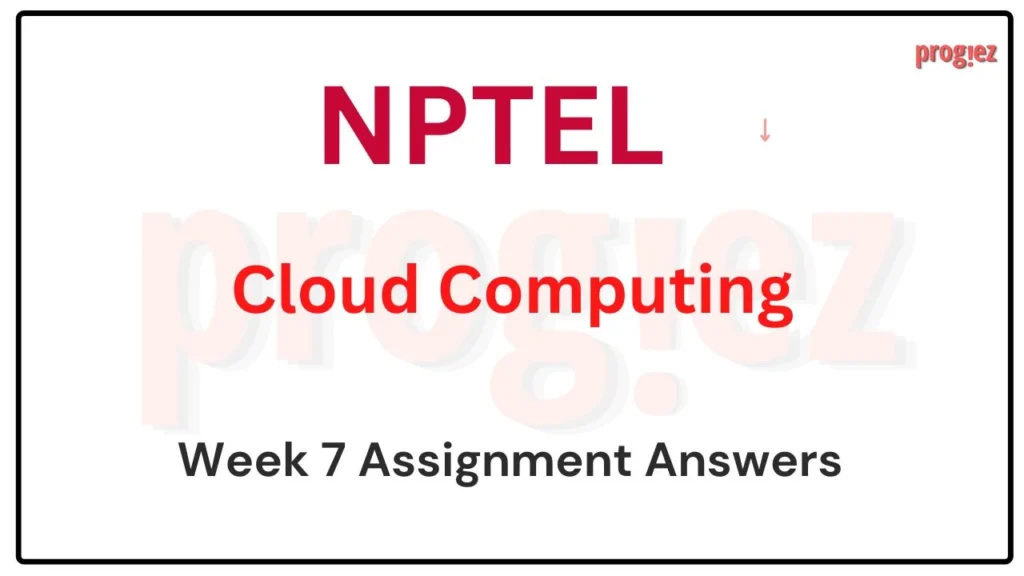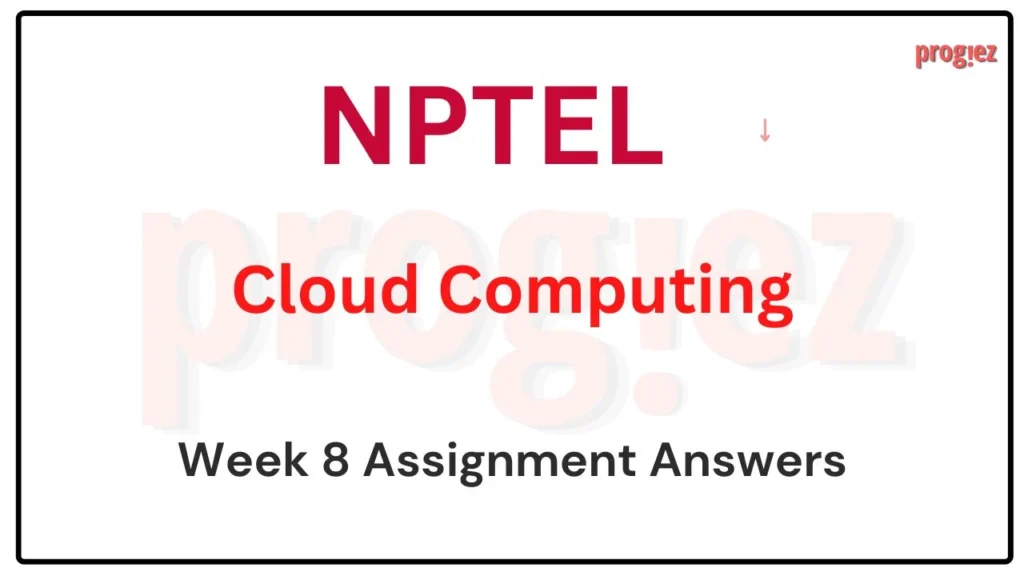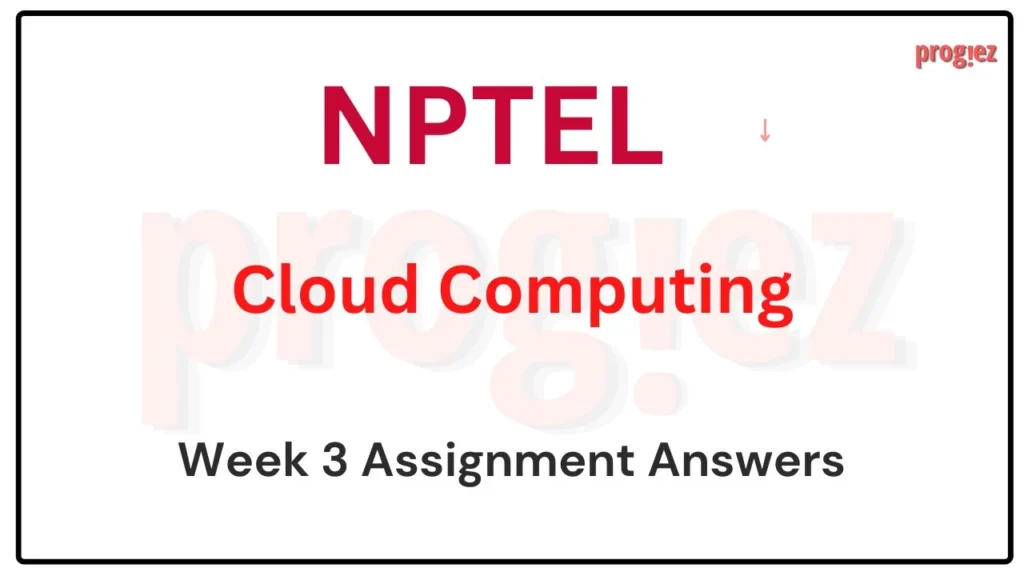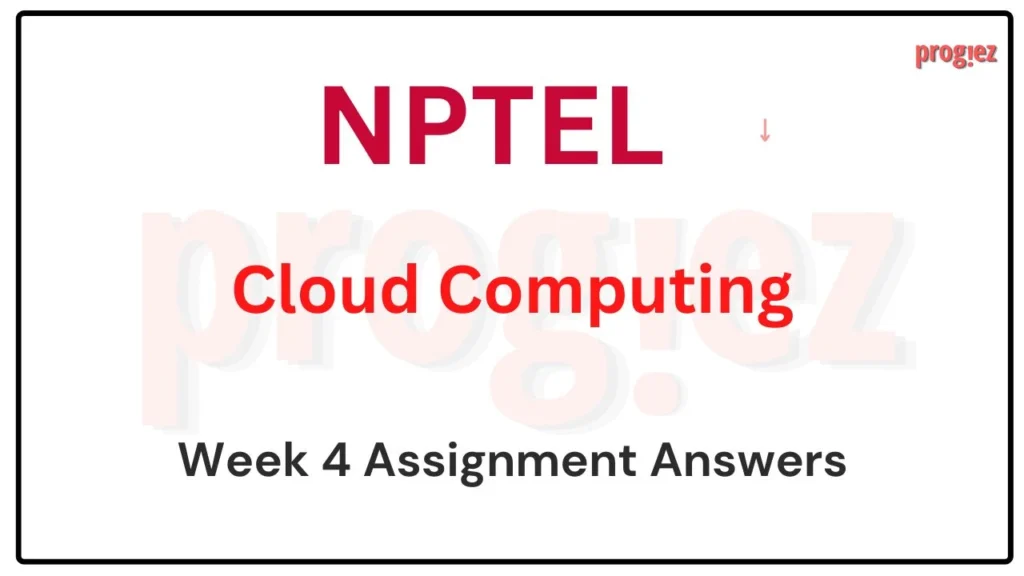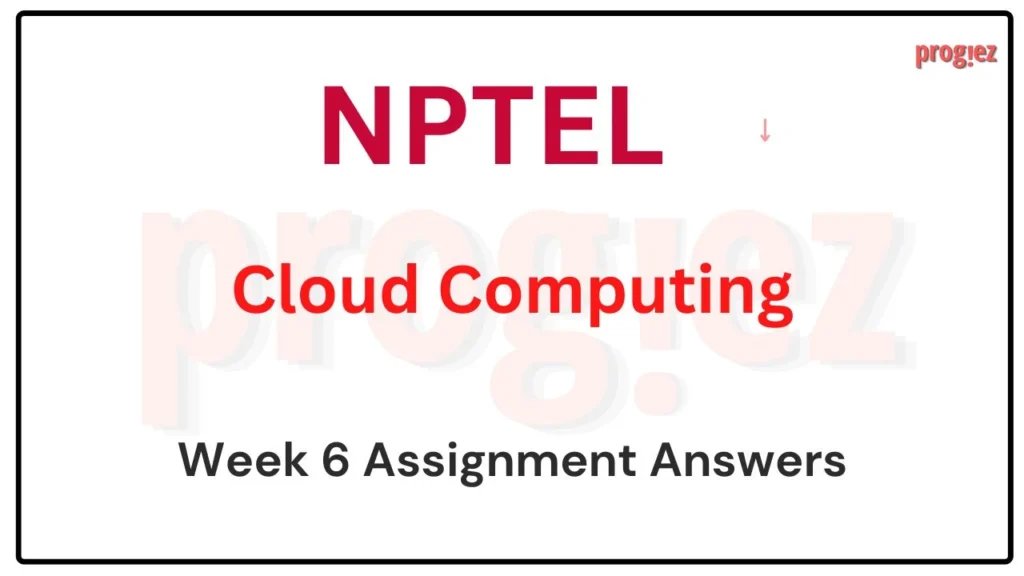Cloud Computing Nptel Week 9 Assignment Answers
Are you looking for the Cloud Computing Nptel Week 9 Assignment Answers Look no further! Our platform provides precise and comprehensive Cloud Computing Nptel Week 9 Assignment Answers for in this course
Course Link: Click Here
Table of Contents
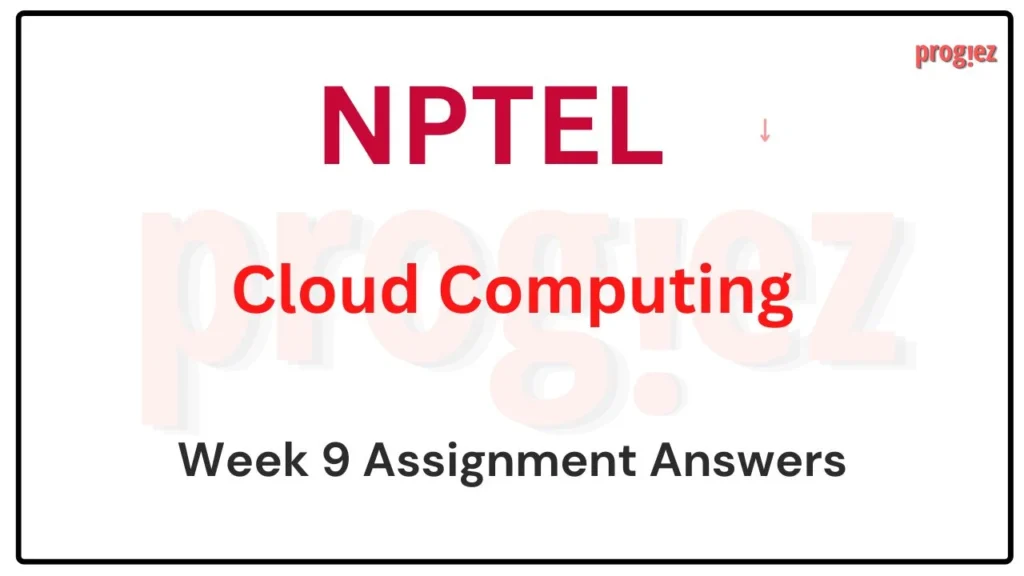
Cloud Computing Nptel Week 9 Assignment Answers (July-Dec 2024)
- Which of the following statements best describes fog computing?
A) Fog computing refers to a model where data, processing, and applications are concentrated in the cloud rather than at the network edge.
B) Fog computing is a term introduced by Cisco Systems to describe a model that centralizes data processing in the cloud to manage wireless data transfer to distributed IoT devices.
C) Fog computing is a model where data, processing, and applications are concentrated in devices at the network edge rather than existing almost entirely in the cloud.
D) The vision of fog computing is to enable applications on a few connected devices to run directly in the cloud without interaction at the network edge.
Answer: C) Fog computing is a model where data, processing, and applications are concentrated in devices at the network edge rather than existing almost entirely in the cloud.
- Which of the following challenges is most effectively addressed by using fog and edge computing instead of a “cloud-only” approach for IoT applications?
A) Resource management issues related to workload balance and task scheduling in cloud-based environments.
B) The inefficiency of processing time-sensitive applications directly in the cloud due to high latency and large data bandwidth requirements.
C) The need for improved security and privacy features in cloud-based systems, which are not addressed by fog and edge computing.
D) The difficulty in integrating multiple cloud services and platforms for comprehensive IoT data management.
Answer: B) The inefficiency of processing time-sensitive applications directly in the cloud due to high latency and large data bandwidth requirements.
- Which of the following correctly describes a classification of resource management architectures in fog/edge computing?
A) Data Flow
B) Control
C) Tenancy
D) Infrastructure
Answer: C) Tenancy
- Which of the following characteristics is NOT typically associated with fog computing infrastructure?
A) Location awareness and low latency
B) Better bandwidth utilization
C) High computational power concentrated solely in the Cloud
D) Support for mobility
Answer: C) High computational power concentrated solely in the Cloud
- In the fog computing paradigm, which of the following accurately describes the relationship between local and global analyses?
A) Local analyses are performed exclusively in the Cloud, while global analyses are done at the edge devices.
B) Local and global analyses are performed only in the Cloud data centers.
C) Local analyses are performed at the edge devices, and global analyses can be either performed at the edge or forwarded to the Cloud.
D) Local analyses are conducted by IoT devices, and global analyses are not necessary in fog computing.
Answer: C) Local analyses are performed at the edge devices, and global analyses can be either performed at the edge or forwarded to the Cloud.
- What is the primary goal of the application placement problem in the Cloud-Fog-Edge framework?
A) To map all applications onto the Cloud servers to maximize computational power.
B) To find available resources in the network that satisfy application requirements, respect constraints, and optimize the objective, such as minimizing energy consumption.
C) To place all application components on edge devices to ensure low latency.
D) To disregard resource capacities and focus solely on network constraints.
Answer: B) To find available resources in the network that satisfy application requirements, respect constraints, and optimize the objective, such as minimizing energy consumption.
- Which of the following is an example of an application constraint in the application placement problem on the Cloud-Fog-Edge framework?
A) Finite capabilities of CPU and RAM on infrastructure nodes.
B) Network latency and bandwidth limitations.
C) Locality requirements restricting certain services’ executions to specific locations.
D) Availability of storage resources in the Fog nodes.
Answer: C) Locality requirements restricting certain services’ executions to specific locations.
- What is the primary purpose of offloading in the context of edge computing?
A) To move all data processing from edge nodes to the cloud.
B) To augment computing requirements by moving servers, applications, and associated data closer to the network edge.
C) To reduce the number of user devices connected to the network.
D) To centralize all computational resources in the cloud for better performance.
Answer: B) To augment computing requirements by moving servers, applications, and associated data closer to the network edge.
- What is the primary goal of a cloud federation?
A) To centralize all cloud services under a single provider.
B) To deploy and manage multiple cloud services to meet business needs by collaborating among different Cloud Service Providers (CSPs).
C) To limit the geographical reach of cloud services.
D) To reduce the number of cloud service providers globally.
Answer: B) To deploy and manage multiple cloud services to meet business needs by collaborating among different Cloud Service Providers (CSPs).
- Which of the following is a key benefit of forming a cloud federation?
A) Centralized control of global cloud services.
B) Increased resource utilization and load balancing across multiple Cloud Service Providers (CSPs).
C) Reduced collaboration among Cloud Service Providers.
D) Limiting the geographical footprint of Cloud Service Providers.
Answer:B) Increased resource utilization and load balancing across multiple Cloud Service Providers (CSPs).
Cloud Computing NPTEL All weeks: Click Here
For answers to additional Nptel courses, please refer to this link: NPTEL Assignment Answers
Cloud Computing Nptel Week 9 Assignment Answers (JAN-APR 2024)
Course Name: Cloud Computing
Course Link: Click Here
For answers or latest updates join our telegram channel: Click here to join
These are Nptel Cloud Computing Assignment 9 Answers
Q1. In which of the following architectures, two or more partner clouds interoperate to aggregate their resources and provide users with a larger virtual infrastructure?
A) Hybrid/Bursting Architecture
B) Aggregated Architecture
C) Broker Architecture
D) Multiplier Architecture
Answer: B) Aggregated Architecture
Q2. Select the correct statement(s) regarding offloading.
A) Offloading is a technique in which a server, an application, and the associated data are moved from the edge to the cloud.
B) Offloading augments the computing requirements of individuals or a collection of user devices.
C) Offloading from cloud to the edge can be achieved by server offloading.
D) Offloading from user device to edge can be achieved by application partitioning.
Answer: b), c), d)
For answers or latest updates join our telegram channel: Click here to join
These are Nptel Cloud Computing Assignment 9 Answers
Q3. Fog computing is a model in which data, processing and applications are concentrated in devices at _________ the rather than existing almost entirely in the cloud.
a. fog
b. local node
c. network station
d. network edge
Answer: d. network edge
Q4. According to the service placement taxonomy in fog-edge computing, which of the following can be classified as online vs offline?
A) Control plan design
B) Placement characteristic
C) System dynamicity
D) Mobility support
Answer: B) Placement characteristic
For answers or latest updates join our telegram channel: Click here to join
These are Nptel Cloud Computing Assignment 9 Answers
Q5. Fog infrastructure consisting of IoT devices, Fog Nodes, and at least one Cloud Data Center never ensures scalability
a. True
b. False
Answer: b. False
Q6. Cloud Federation should prefer maximum geographical separation.
a. True
b. False
Answer: a. True
For answers or latest updates join our telegram channel: Click here to join
Q7. In which of the following cloud federation architectures, creation of cross-site networks and cross- site migration of VMs are used?
A) Loosely coupled federation
B) Partially coupled federation
C) Tightly coupled federation
D) None of the above
Answer: C) Tightly coupled federation
Q8. What is(are) the application placement constraint(s) for fog nodes?
a. Network constraints
b. Interoperability
c. Resource constraints
d. None of these
Answer: a), c)
For answers or latest updates join our telegram channel: Click here to join
These are Nptel Cloud Computing Assignment 9 Answers
Q9. The ___________ used for resource management in fog/edge computing are classified on the basis of data flow, control and tenancy.
a. Algorithms
b. Architectures
c. Hardware
d. Infrastructure
Answer: b. Architectures
Q10. A CSP has little or no control over remote resources in case of
a. Tightly Coupled Federation
b. Medium Coupled Federation
c. Loosely Coupled Federation
d. None of these
Answer: c. Loosely Coupled Federation
For answers or latest updates join our telegram channel: Click here to join
More Weeks of Cloud Computing: Click here
More Nptel Courses: Click here
Cloud Computing Nptel Week 9 Assignment Answers (July-Dec 2023)
Course Name: Cloud Computing
Course Link: Click Here
These are Nptel Cloud Computing Assignment 9 Answers
Q1. Statement I: Fog computing supports real-time interactions which is not the case in cloud computing.
Statement II: Fog computing reduces latency compared to cloud computing.
Select the correct option.
A) Statement I is TRUE and Statement II is FALSE.
B) Statement II is TRUE and Statement I is FALSE.
C) Both statements are TRUE.
D) Both statements are FALSE.
Answer: B) Statement II is TRUE and Statement I is FALSE.
Q2. In the Cloud-Fog-Edge Computing paradigm, Cellular base stations, Network routers and WiFi Gateways can run applications.
A) True
B) False
Answer: A) True
Q3. Which of the following statement(s) are true regarding the cloud-fog environment model?
A) The cloud-fog environment model consists of three layers : a client layer (edge), a fog layer, and a cloud layer.
B) Virtual machines (VMs) operate for the cloud data server, process them, and then deliver the results to the cloud server manager.
C) If there is no/limited availability of resources in the fog layer, then the request is passed to the cloud layer.
D) Fog servers contain fog server manager and virtual machines to manage requests by using container virtualization technique.
Answer: A, C
These are Nptel Cloud Computing Assignment 9 Answers
Q4. Which of the following algorithms used in resource management in cloud-fog-edge computing is used to capture the performance (of entities like, CPU, storage, network, etc.) of a computing system?
A) Discovery
B) Load Balancing
C) Placement
D) Benchmarking
Answer: D) Benchmarking
Q5. According to the service placement taxonomy in fog-edge computing, which of the following can be classified as online ys offline?
A) Control plan design
B) Placement characteristic
C) System dynamicity
D) Mobility support
Answer: B) Placement characteristic
Q6. Select the correct statement(s) regarding offloading.
A) Offloading is a technique in which a server, an application, and the associated data are moved from the edge to the cloud.
B) Offloading augments the computing requirements of individuals or a collection of user devices.
C) Offloading from cloud to the edge can be achieved by server offloading.
D) Offloading from user device to edge can be achieved by application partitioning.
Answer: B, C, D
These are Nptel Cloud Computing Assignment 9 Answers
Q7. Different Cloud Service Providers join together to form a federation.
A) True
B) False
Answer: A) True
Q8. Which of the following are NOT benefits of cloud federation?
A) Minimize resource utilization
B) Load balancing
C) Maximize power consumption
D) Global utility
Answer: A, C
Q9. In which of the following cloud federation architectures, creation of cross site networks and cross site migration of VMs are used?
A) Loosely coupled federation
B) Partially coupled federation
C) Tightly coupled federation
D) None of the above
Answer: C) Tightly coupled federation
Q10. In which of the following architectures, two or more partner clouds interoperate to aggregate their resources and provide users with a larger virtual infrastructure?
A) Hybrid/Bursting Architecture
B) Aggregated Architecture
C) Broker Architecture
D) Multiplier Architecture
Answer: B) Aggregated Architecture
More Weeks: Click here
More Nptel Courses: Click here
Cloud Computing Nptel Week 9 Assignment Answers (JAN-APR 2023)
Course Name: Cloud Computing
Course Link: Click Here
These are Nptel Cloud Computing Assignment 9 Answers
Q1. Fog computing is a model in which data, processing and applications are concentrated in devices at the ________ rather than existing almost entirely in the cloud.
a. fog
b. local node
c. network station
d. network edge
Answer: d. network edge
Q2. In the Cloud-Fog-Edge Computing paradigm, sensors being end devices, can perform basic data processing
a. True
b. False
Answer: a. True
These are Nptel Cloud Computing Assignment 9 Answers
Q3. What is(are) the benefit(s) of Fog computing?
a. Provides less data location-awareness
b. Increases network congestion
c. Causes lesser latency permits usage in real-time applications
d. None of these
Answer: c. Causes lesser latency permits usage in real-time applications
Q4. The _____ used for resource management in fog/edge computing are classified on the basis
of data flow, control and tenancy.
a. Algorithms
b. Architectures
c. Hardware
d. Infrastructure
Answer: b. Architectures
These are Nptel Cloud Computing Assignment 9 Answers
Q5. Virtualization software is an example of _______.
a. Application software
b. Middleware
c. System software
d. Benchmarking
Answer: c. System software
Q6. Fog infrastructure consists of loT devices, Fog Nodes, and at least one Cloud Data Center never ensures scalability
a. True
b. False
Answer: b. False
These are Nptel Cloud Computing Assignment 9 Answers
Q7. What is(are) the application placement constraint(s) for fog nodes?
a. Network constraints
b. Interoperability
c. Resource constraints
d. None of these
Answer: a, c
Q8. Cloud Federation should prefer maximum geographical separation.
a. True
b. False
Answer: a. True
These are Nptel Cloud Computing Assignment 9 Answers
Q9. Benefit(s) of cloud federation is(are)
a. Global Utility
b. Resource utilization minimization
c. Power consumption maximization
d. All of these
Answer: a. Global Utility
Q10. A CSP has little or no control over remote resources in case of
a. Tightly Coupled Federation
b. Medium Coupled Federation
c. Loosely Coupled Federation
d. None of these
Answer: c. Loosely Coupled Federation
These are Nptel Cloud Computing Assignment 9 Answers
All weeks of Cloud Computing: Click here
More NPTEL course: Click Here
Cloud Computing Nptel Week 9 Assignment Answers (July-Dec 2022)
Course name: Cloud Computing NPTEL
Link to Enroll: Click Here
These are Nptel Cloud Computing Assignment 9 Answers
1) Which of the following statements is/are false?
a. Fog and Edge computing are substitutes for cloud computing.
b. Fog and Edge computing may aid cloud computing in overcoming some of the limitations like latency issues.
Answer: a. Fog and Edge computing are substitutes for cloud computing.
2) Which of the following is not a layer of the Cloud-Fog environment model?
a. Client layer
b. Serverless layer
c. Fog layer
d. Cloud layer
Answer: b. Serverless layer
These are Nptel Cloud Computing Assignment 9 Answers
3) In the Cloud-Fog environmental model, servers contain a fog server manager and virtual machines to manage requests by using _________ technique.
a. Image virtualization
b. Container virtualization
c. Server virtualization
d. None of these
Answer: c. Server virtualization
4) The architecture used for resource management in fog/edge computing is classified on the basis of which of the following?
a. Tenancy
b. Data flow
c. Hardware
d. All of these
Answer: a, b
These are Nptel Cloud Computing Assignment 9 Answers
5) Which of the following underlying algorithm(s) is used to facilitate fog/edge computing?
a. Discovery
b. Load balancing
c. Benchmarking
d. Cache Flow
Answer: a, b, c
6) ________ is a technique in which a server, an application and the associated data are moved onto the edge of the network
a. Containerization
b. Virtualization
c. Offloading
d. None of these
Answer: c. Offloading
These are Nptel Cloud Computing Assignment 9 Answers
7) Cloud federation is the collaboration between cloud service providers to achieve which of the following? Choose the most appropriate option(s).
a. Capacity utilization
b. Interoperability
c. Offloading
d. None of these
Answer: a, b
8) Which of the following is false about loosely coupled federation?
a. Limited inter operations between cloud instances.
b. Usually no support for advanced features.
c. Advanced control over remote resources.
d. None of these
Answer: c. Advanced control over remote resources.
These are Nptel Cloud Computing Assignment 9 Answers
9) In which of the following different CSPs establish an agreement stating the terms and conditions under which one partner cloud can use resources from another.
a. Loosely coupled federation
b. Partially coupled federation
c. Tightly coupled federation
d. All of these
Answer: b. Partially coupled federation
10) Hybrid architecture combines the existing on-premise infrastructure (usually a private cloud) with remote resources from one or more public clouds to provide extra capacity to satisfy peak demand periods.
a. True
b. False
Answer: a. True
